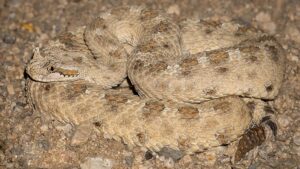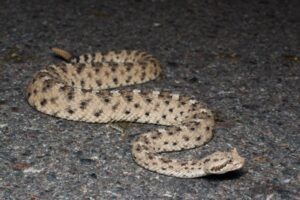The sidewinder snake, alternately known as the sidewinder rattlesnake, sidewinder rattler, or horned rattlesnake, is a pit viper indigenous to the American Southwest’s desert habitats and the northwestern parts of Mexico. They have a unique sidewinding locomotion pattern, moving in a sideways direction, thus resulting in their name. As they move over the loose sand, their body attains a J-shaped pattern, the hook tip pointing towards the direction they travel.
Scientific Classifications
- Suborder:Serpentes
- Family:Viperidae
- Genus:Crotalus
- Species:C. cerastes
Conservation Status
Subspecies
The sidewinder has three recognized subspecies mention as follows:
- Mohave desert sidewinder (C. c. cerastes)
- Sonoran sidewinder (C.c. cercobombus)
- Colorado desert sidewinder (C.c. laterorepens)
Description
Size
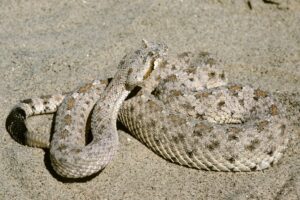
The adult sidewinder snakes measure 19.5 to 31.5 inches in length, the females being larger than their male counterparts, a trait quite unusual in species of this group. These small snakes have an average weight of around 0.55 pounds.
Color and Appearance
They have a base color of buff, cream, ash gray, yellowish-brown or pink with subelliptical or subrhombic blotches arranged dorsally.
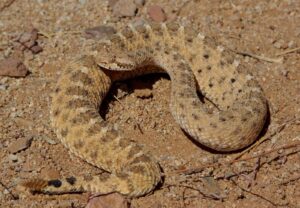
These snakes have keeled scales on the dorsal part of their body arranged in 21 rows. They also have scales arranged ventrally, 141 in males and 144 in females. Another distinctive trait is the raised supraocular scales, which shield the sand from getting into their eyes when the snakes remain buried inside it. No wonder they have alternately been called the horned rattlesnake.
Are They Dangerous to Humans
Though venomous, their venom is comparatively weaker in comparison to that of other rattlesnake species. Moreover, their venom glands are even smaller in size, making them less dangerous than other rattlesnakes. The outcome of their envenomation may lead to several symptoms like swelling, pain, bruising, skin lesion, chill, dizziness, nausea, and even shock in the case of extremities. So, though its venom isn’t that deadly, immediate medical intervention is needed, lest it could become fatal.
Sidewinder Snake at a Glance
Distribution
The sidewinder is native to the southwestern parts of the United States, found in the desert regions of western Arizona, southeastern California, southwestern Utah, and southern Nevada. In the northwestern parts of Mexico their population exists in Baja California, and western Sonora.
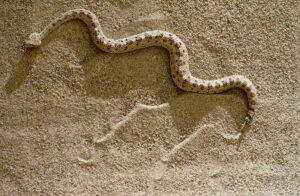
Habitat
A significant part of their habitat is in the sandy areas of the desert regions. In the hotter months, one could see them at night. On the other hand, in the hotter months, they are more active during the daytime.
Lifespan
The females live for 5 years on an average, while the males have a greater longevity, surviving for 13 years. In captivity they survive for 20 years. While females might die after the exhaustive birthing process that lasts 2-3 hours, males often fall victim to excessive predation.
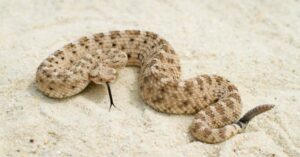
Predators
Some common predators of the sidewinder include birds like shrikes, hawks, and crows, mammals such as coyotes, and raccoons, alongside other snake species like the California kingsnake.
Diet
They prey on rodents like kangaroo rats and lizard species like fringe-toed lizards and whiptail lizards. In captivity, i.e., when kept in zoos, they wholly feed on mice.
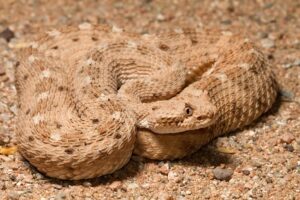
The juveniles follow a trait of caudal luring, using their tails to attract lizards. This behavior isn’t seen in adults much as their prey mainly includes rodents.
The juvenile sidewinders replicate moths and butterflies’ adult and larval stages in their movement, particularly when searching for food. Their fast luring motion is comparable to the fluttering of a moth. The slow movements of their tail are similar to that of a caterpillar.
Reproduction
Mating is the only time when these snakes encounter each other, as they mostly remain on their own, with a density of one sidewinder per hectare. The female sidewinders mate with multiple males, the season commencing between April and May, sometimes extending up to fall.
During mating, the male crawls onto the female’s back, rubbing her body using his chin to stimulate her. He then wraps his tail around hers, so their cloacae (opening through which waste is excreted) come together. If interested, the female consents to the mating by raising her tail. The mating lasts for several hours, and if one partner decides to move, they drag the other along.
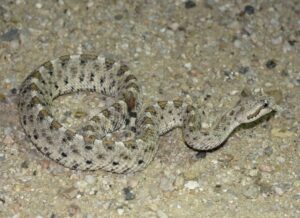
The female sidewinders have a gestation period of 4-5 months, after which 5-18 live young are born. The average number of snakes born in a single litter is 10. After birth, the young sidewinders remain inside the thin and transparent embryonic membranes and emerge within a few minutes while when their mother expels them. The young measure 6-8 inches at birth. They stay in the burrow for around ten days, till the time they shed. Then, the juveniles leave their mother and littermates for good, keeping no contact with them forever.
FAQs
They have an increased speed of 18 miles per hour.
By moving sideways, they can avoid direct contact with the hot sand. This unique adaptation helps these snakes survive the desert environment.
Source
wsed.org, nps.gov, csvcoll.org, sciencephoto.com, scitechdaily.com, a-z-animals.com, wildherps.com

